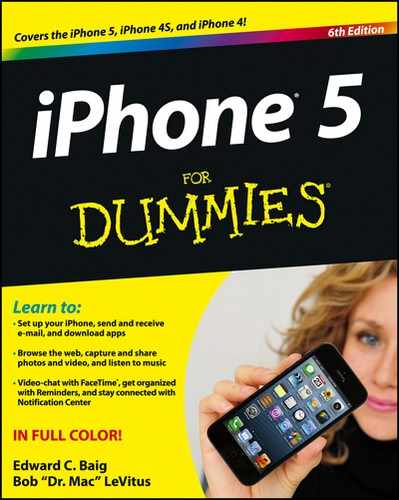Chapter 4
Understanding the Phone-damentals
In This Chapter
![]() Making a call
Making a call
![]() Visualizing visual voicemail
Visualizing visual voicemail
![]() Recording a greeting
Recording a greeting
![]() Calling hands-free
Calling hands-free
![]() Receiving a call
Receiving a call
![]() Choosing ringtones
Choosing ringtones
![]() Setting up conference calls
Setting up conference calls
![]() Facing up to FaceTime
Facing up to FaceTime
Y ou may well have bought an iPhone for its spectacular photo viewer, its marvelous widescreen display, its multimedia capabilities, and the best darn pocket-sized Internet browser you’ve ever come across. Not to mention its overall coolness.
For most of us, though, cool goes only so far. The iPhone’s most critical mission is the one from which its name is derived — it is first and foremost a cell phone. And no matter how capable it is at all those other things, when push comes to shove, you had best be able to make and receive phone calls.
That requirement puts a lot of responsibility in the hands of AT&T, Sprint, and Verizon, the iPhone’s main wireless carriers in the United States. As with any cell phone, the strength of the wireless signal depends a great deal on your location and the robustness of the carrier’s network.
As noted in Chapter 1, the cell signal status icon at the upper-left corner of the screen can clue you in on what your phone-calling experience may be like. Simply put, more bars supposedly equate to a better experience. What you hope to avoid are those two dreaded words: No Service. Cell coverage aside, this chapter is devoted to all the nifty ways you can handle wireless calls on an iPhone.
And when we say nifty, we mean nifty. If you and the person you’re gabbing with have an iPhone 4, 4S, or 5 plus a good Wi-Fi or cellular connection, you can see each other. That’s right: We’re talking about video calling, through a remarkable feature called FaceTime. (FaceTime also lets you make a video call to a friend with an iPad 2 or later tablet, a fourth-generation or later iPod touch, or a Mac computer.)
The promise of video calling has been around since LBJ occupied the White House. But despite various efforts to bring video calling or video chat to computers and certain other mobile handsets, video calling has never really gone Main Street.
We’re betting that with FaceTime, Apple is going to do as much as any outfit this side of Microsoft-owned Skype to change that. Don’t take our word for it; give FaceTime a try. Sorry, but we’re going to leave you hanging until the end of the chapter to figure out how to do that. (Trust us, giving FaceTime a whirl isn’t hard.)
In the meantime, we present more conventional but no less important ways to make and receive calls on your iPhone. Somewhere, Alexander Graham Bell is beaming.
